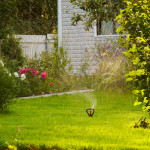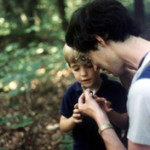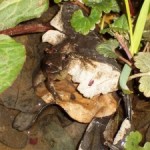This summer, you may want to encourage a toad or two to take up residence in your backyard or garden. One toad can eat up to 10,000 insect pests over the course of the summer. Toads like damp, shady areas and need shelter. If you want to attract a toad, you should provide a good home, or “toad abode” for it. Garden stores or online stores sell plain terracotta or even fancy toad abodes like the one below from Lucinda & Co.:
Toads need water, too, so you should leave tray of water near their abode. Line the toad’s home with leaf mold or leaf litter. Don’t bring toads from elsewhere and put them in your yard (or let loose pet toads). As with your frog pond, build it and (hopefully) the toad will come.
Here’s a solar-powered one with lights.
I’m almost tempted to buy this, but unfortunately I have no toads in my city backyard. Maybe I could use it as a Slug Abode (I’ve got a lot of them!).
Here some more suggestions from the National Wildlife Federation for making your own toad abode:
If you’re on a budget, you can improvise. For instance, half-bury a large flowerpot on its side in a shady spot. Or take the same pot, drill holes at the rim in the shape of a door, tap gently with a hammer to remove the chip, invert and decorate to your heart’s content (nontoxic paints, please). Another option: Arrange flat rocks with a toad-sized space underneath. Situate your toad abode in the shade—say, under a bush—and in the dampest spot in your yard, near a gutter downspout, air-conditioner drip or in a low spot that collects rainwater.
Toads are sensitive to toxins, so don’t use lawn and garden chemicals in your garden or backyard!
Speaking of toads, I’m working on post about Toad Lit, so please send along your suggestions for your favorite children’s books with toad characters.







Growing up as a kid in the rural deep South, my cousins and I made our own toad abodes. The secret was in the sandy, damp soil in our part of North Carolina. You simply sat down, placed your foot flat against the ground, then piled up the moist sand, packing it down until a large igloo shaped dome was left. Then slooowly slip your foot out, and there was a nice moist cave for a toad. It was also a nice excuse to cool your bare feet in the sand. You can also make them out of mud, if you don’t have sand.
We didn’t call them ‘toad abodes’ but rather ‘toe frog houses’. They actually worked!
Thanks, Jimmy, for your comment. That is so interesting–another great way to make a toad abode, or rather a “toe frog house,” and a fun reason to wiggle one’s toes in the sand and mud, too!
Mary Jo
When me and the family went camping over the years, one of my favorite things to do was to see all the wildlife around us. My favorite animal was the wood toad. They were fun to watch, easy to feed, never bit- no teeth- and seemed to enjoy life just hoping around enjoying their surroundings.
I hope the Toad Adobe will bring some toads my way. They are delightful little fellows!
Hi Karen,
Thanks so much for your camping story, stay tuned for the next post…
Susan
I recently came across your blog and have been reading along. I thought I would leave my first comment. I don’t know what to say except that I have enjoyed reading. Nice blog. I will keep visiting this blog very often.
Margaret
http://howtomakecompost.info
Hi Margaret–
Thanks for your comment! So glad you’re enjoying the blog! We really appreciate your feedback.
Mary Jo
We’ve had toad homes for years. Each time we move, we put it in the garden near a leaky faucet in our garden. Sometimes the faucets aren’t leaky so we help it out a wee bit! Before buying one (which they don’t actually use) we just tipped over pots…which they do!
Pingback: Creating a Wildlife- and Eco-friendly Backyard including a Frog Pond | Frogs Are Green
I love all the idea for Toad Abodes, especially the solar-lighted cottage with its own little pool for the toad. I am thinking of a stone design in the shape of a castle with the moat for the water source and a drawbridge for the toad to enter his abode. Your ideas are very cute.
Pingback: transgenic animals
I live in central Georgia and green tree frogs have filled our courtyard fountain with tadpoles…hundreds. I am trying to protect them; we cut off the pumps and have fed them spinach and been careful with their water supply. The problem is that our courtyard is not a natural habitat for frogs…too much concrete. We do have plants back there and we are putting in a pond in that area. How do I set up a natural habitat for my little frogs. They are surviving to jump out of the fountain (we are on our third generation this summer) but I’m not sure they are surviving the hot trip through the courtyard and across a large parking pad before they reach a more natural destination.
Dear Jan,
Thank you for your email. I will post this query on our Facebook page and tag a few people who may have ideas to help you. – Susan
Dear Jan, here is advice from one of our board members, David:
Ground cover with moisture is important for wee frogs moving across concrete to suitable habitat. If You are using potted plants have them on risers so the frogs can get under them for shelter. It’s also a good idea to have pieces of wood and stones around the risen pots, this gives the frogs more of a feeling of security. You can use anything really, but nice pieces of wood, bark, and stones look attractive. Also place bark and other hidey-holes that they can get under in the pot with the plants if there is free space. Clustering pots also increases useable space.
Loose stacks of wood, like split firewood, are great places for frogs. They give both frogs and their prey places to hide. Wood also keeps humidity up, watering the pile lightly during dry spells is a good idea. You can get creative and add soil throughout the wood stack and plant hardy, weedy flowers and such directly in the pile.
Hang small bird houses at various heights against the walls and under eaves. Also use other hides, like flat pieces of bark or old cedar shingles in shady spots parallel to the walls with about 2cm gap for the frogs to slip between. Small, flat perches hung perpendicular to the walls at various heights are also appreciated I say start at 6′ and go up from there
Your pond should be brimming with plants. Lots of emergent and floating leaf plants.
Rushes, sedges and marsh marigolds are great options for emergents as there are small varieties easily available. For example Typha minima is a dwarf variety of cat tail that is a great choice for a smaller pond. There are dwarf water lilies, and a plant called “floating heart” which is a water lily like plant with vibrant yellow flowers. They can be left in their pots or planted directly into the pond, it depends on how the pond is constructed. I like “frog-bit”, it’s a free floating plant that takes up waste products from the water quite nicely.
There are lots of great books focused on attracting wildlife into Your garden.
Look for titles such as
Creating a Wildlife Garden
Landscaping With Nature
Your Backyard Wildlife Garden
Attracting Backyard Wildlife
Books of this category all have sections on making Your garden attractive to amphibians, and do a much more thorough job of describing what needs to be done than I could ever do in a comment, haha.
Good luck with Your frog friends!